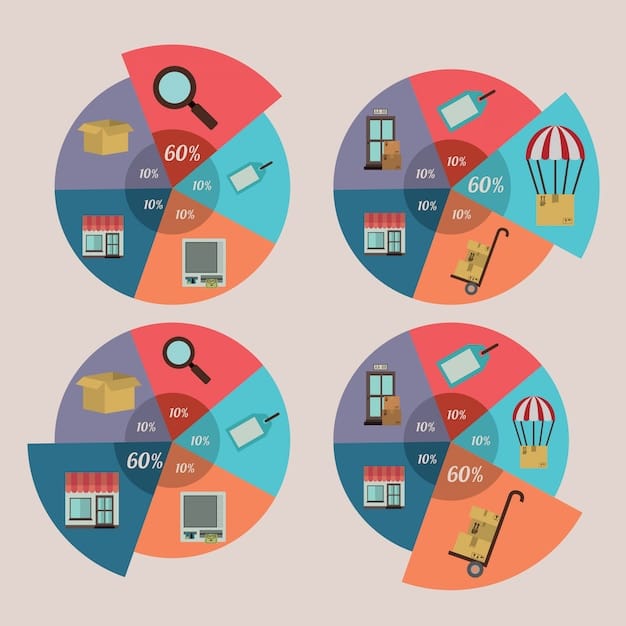Cut Your Monthly Expenses: 7 Proven Strategies to Save $500+

Cutting your monthly expenses can be achieved through strategic budgeting, negotiating bills, reducing discretionary spending, optimizing subscription services, and adopting energy-efficient practices to potentially save $500 or more each month.
Are you looking for practical ways to cut your monthly expenses and free up some extra cash? Saving money doesn’t have to be a daunting task. By implementing a few strategic changes, you can easily save $500 or more each month, giving you more financial flexibility and peace of mind.
Track Your Spending and Create a Budget
Effective money management starts with understanding where your money is going. Tracking your spending habits helps you identify areas where you might be overspending and highlights opportunities for savings. Creating a budget provides a framework for controlling your finances and achieving your financial goals.
Use Budgeting Apps
Budgeting apps like Mint, YNAB (You Need a Budget), and Personal Capital make it easy to track your expenses and create a budget. These apps automatically categorize your spending, making it simple to see where your money is going each month.
Categorize Your Expenses
Divide your expenses into fixed and variable categories. Fixed expenses are consistent amounts like rent or mortgage payments, while variable expenses fluctuate, such as groceries and entertainment. Understanding this breakdown helps you identify discretionary spending that can be reduced.
- Review bank and credit card statements regularly to ensure accuracy and track spending patterns.
- Set realistic spending limits for each category in your budget to avoid overspending.
- Use the envelope method for variable expenses by allocating a fixed amount of cash for each category.
By tracking your spending and creating a budget, you gain better control over your finances and can identify areas where you can make significant savings. This foundational step is essential for achieving your financial goals and improving your overall financial health.

Negotiate Lower Bills
Many people pay more than they need to for essential services such as internet, cable, and insurance. Negotiating lower bills can lead to significant savings without requiring drastic lifestyle changes. Taking the time to negotiate can result in long-term financial benefits.
Call Service Providers
Contact your internet, cable, and phone providers to inquire about lower rates or promotional offers. Often, companies are willing to offer discounts to retain customers. Don’t hesitate to mention competitors’ offers to leverage better deals.
Shop Around for Insurance
Insurance rates can vary significantly between providers. Get quotes from multiple companies for car, home, and life insurance to ensure you’re getting the best possible rate. Consider bundling policies for additional discounts.
- Research average rates in your area to ensure you’re getting a competitive price.
- Consider increasing deductibles to lower your monthly premiums. However, ensure you can comfortably afford the deductible in case of a claim.
- Look for discounts, such as those for safe driving, good credit scores, or being a long-term customer.
Negotiating lower bills is a practical way to save money consistently without sacrificing essential services. By investing a little time in research and negotiation, you can significantly reduce your monthly expenses and free up funds for other financial goals.
Reduce Discretionary Spending
Discretionary spending, or non-essential purchases, often accounts for a significant portion of monthly expenses. Identifying and reducing these expenses can lead to substantial savings without affecting your quality of life. Small changes to your spending habits can add up to big savings over time.
Limit Eating Out
Eating at restaurants or ordering takeout can be expensive. Reduce the frequency of dining out by cooking at home more often. Meal planning and preparation can help you save time and money.
Cut Back on Entertainment
Entertainment expenses, such as movie tickets, concerts, and sporting events, can quickly add up. Find free or low-cost alternatives, such as watching movies at home, attending free community events, or utilizing library resources.
Reducing discretionary spending involves making conscious choices about how you spend your money. By cutting back on non-essential purchases and finding cost-effective alternatives, you can significantly lower your monthly expenses and achieve your financial goals.

- Create a list of your discretionary expenses and prioritize which ones you value most.
- Set a weekly or monthly budget for discretionary spending and stick to it.
- Find free or low-cost activities to replace expensive entertainment options.
Optimize Subscription Services
Subscription services, such as streaming platforms, gym memberships, and software subscriptions, often go unused but continue to drain your bank account. Regularly reviewing and optimizing these services can result in substantial savings.
Cancel Unused Subscriptions
Identify any subscriptions you no longer use or need. Cancel these services to eliminate unnecessary monthly charges. Use apps or budgeting tools to track your subscriptions and ensure you’re not paying for services you don’t use.
Downgrade or Share Subscriptions
Consider downgrading to a cheaper plan or sharing subscriptions with family or friends. Many streaming services offer multiple viewing options, allowing you to split the cost with others.
- Audit your subscriptions every few months to ensure you’re getting value from each service.
- Negotiate lower rates with service providers or switch to cheaper alternatives.
- Take advantage of free trials but remember to cancel before the trial period ends to avoid being charged.
Optimizing your subscription services is a simple yet effective way to save money without sacrificing access to the content and services you enjoy. Regularly reviewing and adjusting your subscriptions can free up significant funds for other financial goals.
Reduce Energy Consumption
Reducing energy consumption not only benefits the environment but also lowers your utility bills. Simple changes to your energy usage habits can lead to significant savings each month.
Use Energy-Efficient Appliances
Replace old appliances with energy-efficient models. Look for appliances with the Energy Star label, which indicates they meet strict energy efficiency guidelines. While the initial investment may be higher, the long-term savings can be substantial.
Adjust Your Thermostat
Adjust your thermostat to save energy while you’re away from home or sleeping. Lowering the temperature in the winter and raising it in the summer can significantly reduce your heating and cooling costs.
Reducing energy consumption is a win-win strategy that benefits both your wallet and the environment. By adopting energy-efficient practices and making small changes to your energy usage habits, you can lower your utility bills and contribute to a more sustainable future.
- Unplug electronics and appliances when not in use to avoid standby power consumption.
- Use LED lighting, which consumes significantly less energy than traditional incandescent bulbs.
- Seal windows and doors to prevent drafts and improve insulation.
Refinance Debt
Refinancing debt involves replacing existing loans with new loans that have more favorable terms, such as lower interest rates or longer repayment periods. This can significantly reduce your monthly payments and save you money over the life of the loan.
Refinance Student Loans
If you have student loans, consider refinancing to a lower interest rate. A lower rate can significantly reduce your monthly payments and save you thousands of dollars over the life of the loan. Compare offers from multiple lenders to find the best deal.
Consolidate Credit Card Debt
If you have multiple credit card balances with high interest rates, consider consolidating your debt into a single loan with a lower interest rate. This can simplify your payments and save you money on interest charges.
- Check your credit score before applying for refinancing or consolidation to ensure you qualify for the best rates.
- Calculate the total cost of the new loan, including fees, to ensure it’s a better deal than your existing loans.
- Be wary of offers that seem too good to be true and always read the fine print.
Refinancing debt can be a powerful tool for reducing your monthly expenses and improving your financial health. By taking the time to shop around for the best rates and terms, you can save significant amounts of money over the long term.
Automate Savings
Automating your savings involves setting up automatic transfers from your checking account to your savings or investment accounts. This ensures you consistently save money without having to think about it. Automation can help you reach your financial goals faster and more efficiently.
Set Up Automatic Transfers
Establish regular, automatic transfers from your checking account to your savings or investment accounts. Even small, consistent contributions can add up over time. Treat savings like a bill by scheduling it as a recurring payment.
Use Round-Up Apps
Round-up apps, such as Acorns and Qapital, automatically round up your purchases to the nearest dollar and invest the difference. This allows you to save money without even noticing it.
Automating savings is a simple and effective way to build wealth and achieve your financial goals. By setting up automatic transfers and using round-up apps, you can consistently save money without having to actively manage it, making it easier to secure your financial future.
- Start small and gradually increase your automatic savings contributions over time.
- Set specific savings goals, such as a down payment on a house or retirement, to stay motivated.
- Review your automated savings plan regularly to ensure it aligns with your financial goals.
| Key Point | Brief Description |
|---|---|
| 📊 Track Spending | Monitor your expenses to identify areas for potential savings. |
| 📞 Negotiate Bills | Contact providers for lower rates on services like internet and insurance. |
| 🎬 Reduce Entertainment | Find cost-effective alternatives to expensive entertainment. |
| 💰 Automate Savings | Set up automatic transfers to savings or investment accounts. |
Frequently Asked Questions
▼
Start by using budgeting apps, spreadsheets, or even a simple notebook to record all your expenses for a month. Categorize each expense to see where your money is going.
▼
You can negotiate internet, cable, phone, and insurance bills. Call service providers and inquire about lower rates or shop around for better insurance deals.
▼
Limit eating out, cut back on expensive entertainment, and find free or low-cost alternatives for leisure activities. Prioritize your spending based on your values.
▼
Optimizing subscriptions helps you avoid paying for unused services. Cancel subscriptions you don’t need or downgrade to cheaper plans to save money each month.
▼
Automating savings makes it consistent and effortless. By setting up automatic transfers, you ensure you save money regularly without having to actively manage it.
Conclusion
Cutting your monthly expenses doesn’t require extreme measures. By implementing these seven proven strategies, you can easily save $500 or more each month. Start tracking your spending, negotiate bills, reduce discretionary spending, optimize subscriptions, reduce energy consumption, refinance debt, and automate savings to achieve your financial goals and enjoy greater financial freedom.





